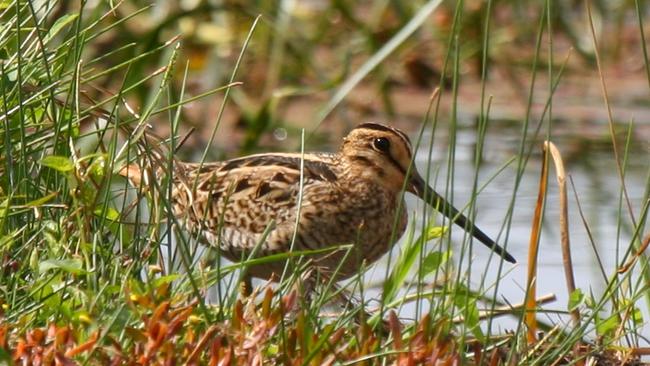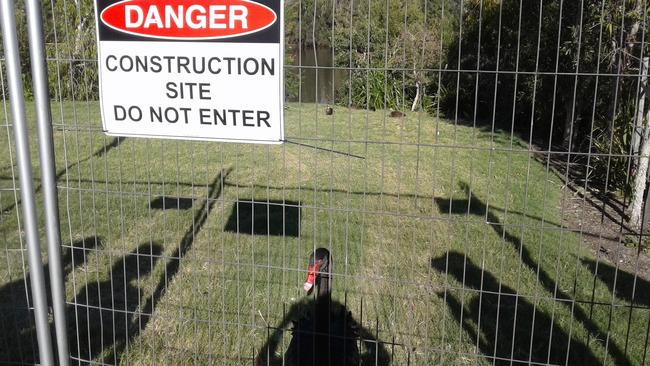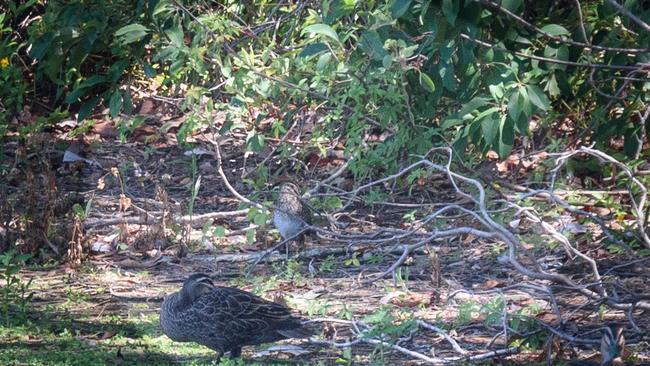Small bird could save Black Swan Lake as residents identify vulnerable Japanese snipe
A PROTECTED and vulnerable species of migratory bird has been spotted at Black Swan Lake as the Gold Coast Turf Club starts work to fill in the waterway.

Pets & wildlife
Don't miss out on the headlines from Pets & wildlife. Followed categories will be added to My News.
A MIGRATORY bird that protesting residents say is a protected and vulnerable species has been spotted at Black Swan Lake as the Gold Coast Turf Club starts work to fill in the waterway.
The Bulletin has obtained several photographs taken by residents of what they say has been identified as a Latham’s Snipe among birds on the Bundall lake’s tree-lined foreshore.
Wildlife Queensland member and concerned resident Karen McCarthy has written to both the council and the Turf Club calling for a referral to be made to the Federal Environment Department about the planned works.
“I thought it best to inform you that a Latham Snipe has been identified at Black Swan Lake, witnessed by four people and documented and photographed extensively,” she wrote.

The bird was a migratory species featured under the Bonn Convention and conserved through agreements, she said.
A department officer replied that the information had been provided to an “assessments area” and the Turf Club was contacted.
“I can advise that the department has formally written to the developers to ensure they are aware of the obligations to consider the potential impacts of the development on matters of national environmental significance,” the department staffer wrote.

“Should a referral be submitted to the department, it will be made available for public comment on the department’s website.”
A council spokesperson confirmed the email was received and it “will deal with it in due course”.
Residents and environmentalists are seeking the referral because it will give the public at window of at least a fortnight to provide arguments to stop the Turf Club filling in what it calls a 2.7ha “borrow pit” for training amenities, an equine green space and overflow car parking.

The Department of Environment and Energy literature on the bird says the Latham Snipe does not aggregate in large flocks or use the same habitats as many other shorebird species.
Under the city plan, Latham’s Snipe is listed as a significant fauna species that has a low number of records within the Gold Coast and requires a specialised habitat.
Latham’s Snipe is one of 37 migratory shorebirds in Australia listed as such under the Environment Protection and Biodiversity Conservation Act, and the species also features in the Japan-Australia migratory bird agreement.
While the numbers of the birds may not show Black Swan Lake is a significant habitat, the Turf Club would need to alert authorities and failure could result in severe penalties including seven years jail.

In her email, Ms McCarthy asked for a referral to the department, adding: “You may already have knowledge of this fact (that the bird is here) from a bird census you had done on this site last year. Please feel free to provide us with a copy of this census if you feel it would help cut down on the email traffic regarding this subject.”
Australian researchers suspect the species is in decline and may need its conservation status reviewed. The 200 gram birds fly 8000 kilometres from Hokkaido in northern Japan to southeastern Australia between August and September.
Wildlife Queensland Gold Coast spokesperson Sally Spain said residents had concerns about research undertaken by the Turf Club on habitat.
Documents provided to the council by consultants for the club found after a site inspection there were “very low numbers of terrestrial or predominantly terrestrial fauna”.

Consultants found the Pacific black duck, no black swans and the only breeding place recorded belonged to the Willy Wagtail.
Birdlife Australia says surveys show that Black Swan Lake is home to hundreds of birds with over 60 species, many breeding on and around the lake.
“Volunteer organisations are doing the research. Our perception is it (the club’s report) was not thorough enough,” Ms Spain said.
She estimated 16,000 people were backing a petition to save the lake after more than 10,000 objected to the move to fill it in.
“The legislation is protective, but there are some people saying it is not strong enough. If these birds are coming to the lake and are rare species, we need to keep the habitat,” Ms Spain said.
FAST FACTS ON LATHAMS SNIPE
The small migratory wader from Japan visits Australia in the warmer months.
It is the largest snipe here, has a long, straight bill and mainly brown plumage.
Snipes are shy and if disturbed will scatter, taking off with a “crek” call.
In the southern states they are vulnerable, sparking protection campaigns.
They leave their breeding areas from August to November, arriving in Australia mainly in September and by February are gone from the Coast.


